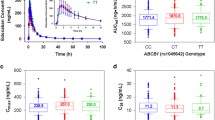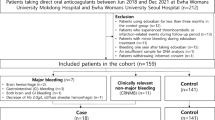Abstract
Introduction
Dabigatran is a direct oral anticoagulant (DOAC) used for the treatment of several thrombotic conditions. To date, very few pharmacogenetic studies on dabigatran were published. We aimed to investigate the influence of 59 polymorphisms in 15 genes (including CES1, UGT and CYP that encode enzymes and ABCB1 and SLC that encode transporters), concomitant treatment with pantoprazole and demographic characteristics (including sex or race) on dabigatran pharmacokinetics and safety.
Methods
This was a candidate gene pharmacogenetic study. The study population comprised 107 volunteers enrolled in two dabigatran bioequivalence clinical trials; they were genotyped with a ThermoFisher QuantStudio 12K Flex OpenArray instrument. SPSS software v.21 was used for statistical analysis.
Results
Women showed a higher exposure to dabigatran compared to men. The concomitant treatment with pantoprazole was associated with a decreased exposure to the drug. CYP2D6 poor metabolizers (PMs) were related to lower clearance (Cl/F) (p = 0.049) and a tendency was observed towards higher area under the curve (AUC), maximum concentration (Cmax) and to lower volume of distribution (Vd/F) (p < 0.10). SLC22A1 haplotype was related to pharmacokinetic variability (p < 0.05). The remaining genes (including CYP, UGT1A1 and ABCB1) had no effect on dabigatran pharmacokinetics (p > 0.10). Women showed more adverse drug reactions (ADR) compared to men (0.40 ± 0.68 vs 0.15 ± 0.41 ADR per person, p = 0.03) and SLC22A1 mutant haplotype was related to a lower risk of nausea (p = 0.02).
Conclusion
Sex, concomitant use of pantoprazole and SLC22A1, CYP2D6 and CYP3A5 polymorphism had an effect on dabigatran pharmacokinetics and safety. Previously published pharmacogenetic predictors, namely CES1 or ABCB1 polymorphisms, had no effect on pharmacokinetics and safety. This study is of interest as it increases the scarce pharmacogenetic information on dabigatran.

Similar content being viewed by others
References
Agencia Española del Medicamento y Productos Sanitarios (AEMPS). Pradaxa 75 mg cápsulas duras, Ficha Técnica o Resumen de las Características del Producto. https://cima.aemps.es/cima/pdfs/es/ft/08442002/FT_08442002.html.pdf
Ebner T, Wagner K, Wienen W. Dabigatran acylglucuronide, the major human metabolite of dabigatran: in vitro formation, stability, and pharmacological activity. Drug Metab Dispos. 2010;38:1567–75.
Hu Z-Y, Parker RB, Herring VL, Laizure SC. Conventional liquid chromatography/triple quadrupole mass spectrometry based metabolite identification and semi-quantitative estimation approach in the investigation of in vitro dabigatran etexilate metabolism. Anal Bioanal Chem. 2013;405:1695–704.
Ganetsky M, Babu KM, Salhanick SD, Brown RS, Boyer EW. Dabigatran: review of pharmacology and management of bleeding complications of this novel oral anticoagulant. J Med Toxicol. 2011;7:281–7.
Blech S, Ebner T, Ludwig-Schwellinger E, Stangier J, Roth W. The metabolism and disposition of the oral direct thrombin inhibitor, dabigatran, in humans. Drug Metab Dispos. 2008;36:386–99.
Farmakis D, Davlouros P, Giamouzis G, et al. Direct oral anticoagulants in nonvalvular atrial fibrillation: practical considerations on the choice of agent and dosing. Cardiology. 2018;140:126–32.
Thorn CF, Klein TE, Altman RB. PharmGKB: the pharmacogenomics knowledge base. In: Innocenti F, van Schaik RHN, editors. Pharmacogenomics. Totowa, NJ: Humana Press; 2013. p. 311–20. https://link.springer.com/10.1007/978-1-62703-435-7_20. Accessed 7 Jan 2020.
Gouin-Thibault I, Delavenne X, Blanchard A, et al. Interindividual variability in dabigatran and rivaroxaban exposure: contribution of ABCB1 genetic polymorphisms and interaction with clarithromycin. J Thromb Haemost. 2017;15:273–83.
Paré G, Eriksson N, Lehr T, et al. Genetic determinants of dabigatran plasma levels and their relation to bleeding. Circulation. 2013;127:1404–12.
Dimatteo C, D’Andrea G, Vecchione G, et al. Pharmacogenetics of dabigatran etexilate interindividual variability. Thromb Res. 2016;144:1–5.
European Medicines Agency. Dabigatran etexilate hard capsule 75 mg, 110 mg and 150 mg product -specific bioequivalence guidance. https://www.ema.europa.eu/en/documents/scientific-guideline/dabigatran-etexilate-hard-capsule-75-mg-110-mg-150-mg-product-specific-bioequivalence-guidance_en.pdf.
Aguirre C, García M. Causality assessment in reports on adverse drug reactions. Algorithm of Spanish pharmacovigilance system. Med Clin (Barc). 2016;147:461–4.
Belmonte C, Ochoa D, Román M, et al. Influence of CYP2D6, CYP3A4, CYP3A5 and ABCB1 polymorphisms on pharmacokinetics and safety of aripiprazole in healthy volunteers. Basic Clin Pharmacol Toxicol. 2018;122:596–605.
Caudle KE, Sangkuhl K, Whirl‐Carrillo M, et al. Standardizing CYP 2D6 genotype to phenotype translation: consensus recommendations from the clinical pharmacogenetics implementation consortium and Dutch pharmacogenetics working group. Clinical and Translational Science. 2019. https://onlinelibrary.wiley.com/doi/abs/10.1111/cts.12692. Accessed 12 Dec 2019.
Scott SA, Sangkuhl K, Stein CM, et al. Clinical pharmacogenetics implementation consortium guidelines for CYP2C19 genotype and clopidogrel therapy: 2013 update. Clin Pharmacol Ther. 2013;94:317–23.
Caudle KE, Rettie AE, Whirl-Carrillo M, et al. Clinical pharmacogenetics implementation consortium guidelines for CYP2C9 and HLA-B genotypes and phenytoin dosing. Clin Pharmacol Ther. 2014;96:542–8.
Zubiaur P, Saiz-Rodríguez M, Ochoa D, et al. Influence of CYP2B6 activity score on the pharmacokinetics and safety of single dose efavirenz in healthy volunteers. Pharmacogenomics J. 2019. https://www.nature.com/articles/s41397-019-0103-3. Accessed 7 Jan 2020.
Saiz-Rodríguez M, Ochoa D, Belmonte C, et al. Polymorphisms in CYP1A2, CYP2C9 and ABCB1 affect agomelatine pharmacokinetics. J Psychopharmacol (Oxford). 2019;33:522–31.
Mittal B, Tulsyan S, Mittal R. The effect of ABCB1 polymorphisms on the outcome of breast cancer treatment. Pharmacogenomics Pers Med. 2016;9:47–58.
U.S. Food and Drug Administration (FDA). Drugs@FDA: FDA-Approved Drugs—Pradaxa. https://www.accessdata.fda.gov/scripts/cder/daf/index.cfm?event=overview.process&applno=022512. Accessed 19 Oct 2010.
European Medicines Agency. European public assessment report (EPAR) summary for Pradaxa. https://www.ema.europa.eu/en/medicines/human/EPAR/pradaxa. Accessed 17 Mar 2008.
Blair HA, Keating GM. Dabigatran etexilate: a review in nonvalvular atrial fibrillation. Drugs. 2017;77:331–44.
Yao X, Abraham NS, Sangaralingham LR, et al. Effectiveness and safety of dabigatran, rivaroxaban, and apixaban versus warfarin in nonvalvular atrial fibrillation. J Am Heart Assoc. 2016;5. https://www.ahajournals.org/doi/10.1161/JAHA.116.003725. Accessed 17 Jan 2020.
Reilly PA, Lehr T, Haertter S, et al. The effect of dabigatran plasma concentrations and patient characteristics on the frequency of ischemic stroke and major bleeding in atrial fibrillation patients. J Am Coll Cardiol. 2014;63:321–8.
Kuwayama T, Osanai H, Ajioka M, et al. Influence of proton pump inhibitors on blood dabigatran concentrations in Japanese patients with non-valvular atrial fibrillation. J Arrhythmia. 2017;33:619–23.
Bolek T, Samoš M, Stančiaková L, et al. The impact of proton pump inhibition on dabigatran levels in patients with atrial fibrillation. Am J Ther. 2019;26:e308–e313313.
Padrini R. Clinical pharmacokinetics and pharmacodynamics of direct oral anticoagulants in patients with renal failure. Eur J Drug Metab Pharmacokinet. 2019;44:1–12.
Shi J, Wang X, Nguyen J-H, et al. Dabigatran etexilate activation is affected by the CES1 genetic polymorphism G143E (rs71647871) and gender. Biochem Pharmacol. 2016;119:76–84.
Sychev DA, Levanov A, Shelekhova T, et al. The impact of ABCB1 (rs1045642 and rs4148738) and CES1 (rs2244613) gene polymorphisms on dabigatran equilibrium peak concentration in patients after total knee arthroplasty. Pharmacogenomics Pers Med. 2018;11:127–37.
Zubiaur P, Saiz-Rodríguez M, Koller D, Ovejero-Benito MC, Wojnicz A, Abad-Santos F. How to make P-glycoprotein (ABCB1 , MDR1) harbor mutations and measure its expression and activity in cell cultures? Pharmacogenomics. 2018; https://www.futuremedicine.com/doi/10.2217/pgs-2018-0101. Accessed 18 Oct 2018.
Stewart A. SLCO1B1 Polymorphisms and statin-induced myopathy. PLoS Curr. 2013. https://currents.plos.org/genomictests/?p=21697. Accessed 9 Jun 2020.
Goswami S, Gong L, Giacomini K, Altman RB, Klein TE. PharmGKB summary: very important pharmacogene information for SLC22A1. Pharmacogenet Genomics. 2014;24:324–8.
Jonker JW, Wagenaar E, Mol CAAM, et al. Reduced hepatic uptake and intestinal excretion of organic cations in mice with a targeted disruption of the organic cation transporter 1 (Oct1 [Slc22a1]) Gene. Mol Cell Biol. 2001;21:5471–7.
Acknowledgements
The authors are thankful to the volunteers and the effort of the staff of the Clinical Trial Unit of Hospital Universitario de La Princesa.
Funding
D. Koller is financed by the H2020 Marie Sklodowska-Curie Innovative Training Network 721236 grant. Marcos Navares-Gómez is co-financed by the European Social Fund and the Youth European Initiative, grant number PEJ-2018-TL/BMD-11080. No Rapid Service Fee was received by the journal for the publication of this article.
Authorship
All named authors meet the International Committee of Medical Journal Editors (ICMJE) criteria for authorship for this article, take responsibility for the integrity of the work as a whole, and have given their approval for this version to be published.
Authorship Contributions
Pablo Zubiaur, Miriam Saiz-Rodríguez, Dolores Ochoa, Marcos Navares-Gómez, Gina Mejía, Manuel Román, Dora Koller, Paula Soria-Chacartegui, Susana Almenara and Francisco Abad-Santos contributed to drafting and revising the manuscript. Pablo Zubiaur and Francisco Abad-Santos designed the research. Pablo Zubiaur, Miriam Saiz-Rodríguez, Marcos Navares-Gómez, Dora Koller and Paula Soria-Chacartegui conducted all experiments and statistical analyses.
Disclosures
Francisco Abad-Santos and Dolores Ochoa have been consultants or investigators in clinical trials sponsored by the following pharmaceutical companies: Abbott, Alter, Chemo, Cinfa, FAES Farma, Farmalíder, Ferrer, GlaxoSmithKline, Galenicum, Gilead, Italfarmaco, Janssen-Cilag, Kern Pharma, Normon, Novartis, Servier, Silverpharma, Teva, and Zambon. Pablo Zubiaur, Miriam Saiz-Rodríguez, Marcos Navares-Gómez, Gina Mejía, Manuel Román, Dora Koller, Paula Soria-Chacartegui and Susana Almenara have nothing to disclose.
Compliance with Ethics Guidelines
The study population comprised healthy volunteers enrolled in two bioequivalence clinical trials performed in the clinical trial unit of Hospital Universitario de La Princesa (UECHUP), Madrid (Spain). They were accomplished under the guidelines of Good Clinical Practice and complied with Spanish legislation on clinical research in humans. Both were approved and authorised by the Hospital’s Research Ethics Committee (CEIm) (protocol numbers 3646 and 3736, respectively) and the Spanish Drugs Agency (AEMPS). All subjects gave their informed consent for the clinical trial and 107 of them for the pharmacogenetic study. This research complied with international standards, including the Declaration of Helsinki 1964 and its later amendments.
Data Availability
The data that support the findings of this study are available from the corresponding author upon reasonable request.
Author information
Authors and Affiliations
Corresponding author
Additional information
Digital Features
To view digital features for this article go to https://doi.org/10.6084/m9.figshare.12471773.
Rights and permissions
About this article
Cite this article
Zubiaur, P., Saiz-Rodríguez, M., Ochoa, D. et al. Effect of Sex, Use of Pantoprazole and Polymorphisms in SLC22A1, ABCB1, CES1, CYP3A5 and CYP2D6 on the Pharmacokinetics and Safety of Dabigatran. Adv Ther 37, 3537–3550 (2020). https://doi.org/10.1007/s12325-020-01414-x
Received:
Published:
Issue Date:
DOI: https://doi.org/10.1007/s12325-020-01414-x




